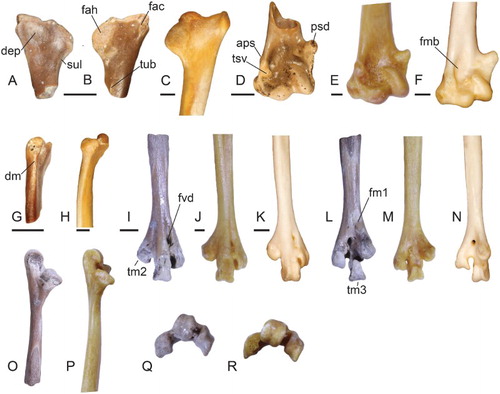Figures & data
Figure 1. Coracoids of the early Miocene Neilus sansomae gen. et sp. nov. (A, E–H), and the late Oligocene Chionoides australiensis gen. et sp. nov. (I, K, M) in comparison with the extant Black-faced Sheathbill Chionis minor (NMV B.30769) (B, J, L, N), and the Magellanic Plover Pluvianellus socialis (AMNH 17700) (C, D). Left coracoid of N. sansomae (holotype, NMNZ S.52628) in A, ventral, E, dorsomedial, F, dorsal, G, medial and H, lateral views. Right coracoid (reversed) of Chionis minor in B, N, ventral, J, medial and L, dorsal views. Left coracoid of Chionoides australiensis (holotype, SAM P41458) in I, medial, K, dorsal, M, ventral and O, lateral views. Right coracoid (reversed) of P. socialis in C, ventral and D, dorsomedial views. Abbreviations: cs, cotyla scapularis; da, dorsal area ventromedial of facies articularis humeralis; fac, facies articularis clavicularis; fah, facies articularis humeralis; ila, impressio ligamenti acrocoracohumeralis; ims, impressio m. sternocoracoidei; lgd1, ventromedial ligamental insertion area; lgd2, craniodorsal ligamental insertion area; pac, processus acrocoracoideus; pmm, projection on margo medialis; rid, ridge; ssc, sulcus m. supracoracoidei; tbr, tuberculum brachiale; tub, tuberosity; vfac, ventral facet of facies articularis clavicularis. Scale bars equal 2 mm. We note that C was supplied and is at a different angle compared to Figure 1A and B.

Figure 2. Postcranial elements tentatively attributed to Neilus sansomae gen. et sp. nov. (A, B, D, G, I, L, O, Q) in comparison to sheathbills (C, E, H, J, M, P, R) and the Magellanic Plover (AMNH 17700) ( F, K, N). Left scapulae of N. sansomae (NMNZ S.52888) (A, B, G) and Chionis albus (NMNZ OR.22149) (C, H) in A, medial, B, C, lateral and G, H, dorsal views. D, Left humerus (NMNZ S.44208) of N. sansomae in cranial view. Right humeri (reversed) of E, Chionis minor (NMV B.30769) and F, P. socialis in cranial view. Left tarsometatarsi of N. sansomae (CM 2013.18.684) (I, L, O, Q), C. minor (J, M, P, R), and P. socialis (K, N) in I, K, dorsal, L–N, plantar, O, P, medial and Q, R, distal views. Abbreviations: aps, attachment for m. pronator superficialis; dep, depression; dm, dorsal margin; fac, facies articularis clavicularis; fah, facies articularis humeralis; fm1, fossa metatarsi I; fmb, fossa m. brachialis; fvd, foramen vasculare distale; lig, ligamentum collaterale ventrale; psd, processus supracondylaris ventralis; sul, sulcus; tm2, trochlea metatarsi II; tm3, trochlea metatarsi III; tsv, tuberculum supracondylare ventrale; tub, tubercle. Scale bars equal 2 mm; O–R not to scale.

